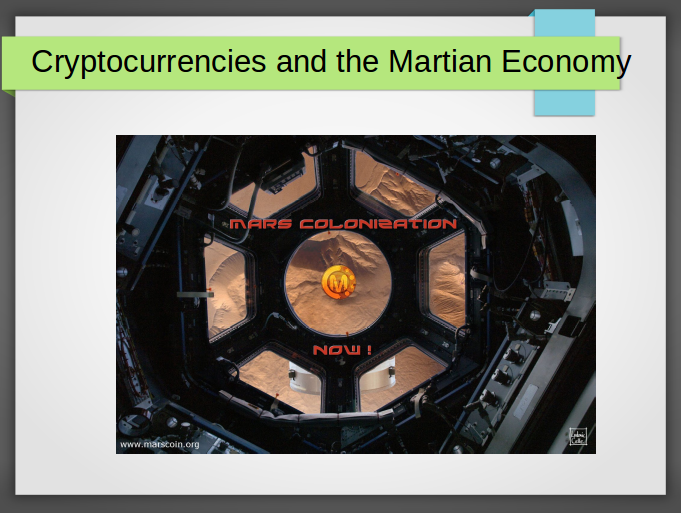
Interplanetary trade is going to become a thing in the coming centuries. Mining companies are going to be hauling loads of valuable ore mined in the asteroid belt. We’ll have trade between colonies. One thing that’s missing, though, is the fact that banks don’t exist on Mars. And of course some people would say, “Who needs banks, anyway?” They aren’t completely wrong even if their colony might not become a stop on the interplanetary Silk Road because traders think that the trip out to their colony is unprofitable. However, what they get right is that new technologies can make traditional forms of currency like gold, silver and paper money obsolete.
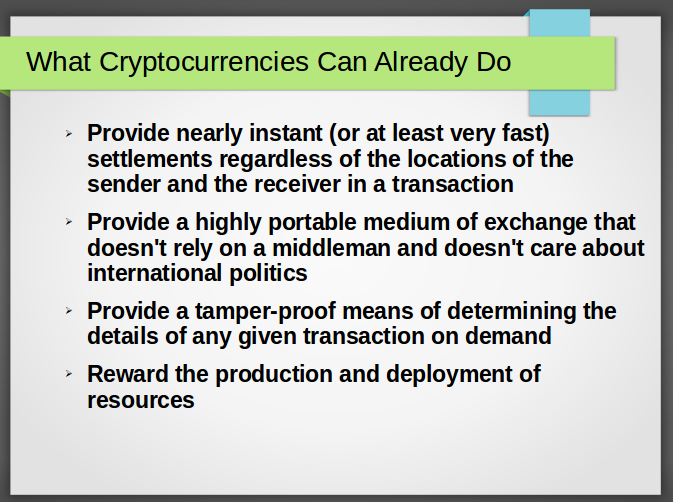
Cryptocurrencies like Bitcoin can confirm transactions at literally the speed of light or, if you’d rather not wait out the time delay between Earth and Mars, temporarily store transaction data in a sidechain until it can sync up with the main system. Call them a prototype for Federation Credits that make it possible for Lieutenant Uhura to go shopping on Space Station K-9 without carrying a bulky purse around, if you like. Cryptocurrencies can already do four things:
-
Provide nearly instant (or at least very fast) settlements regardless of the locations of the sender and the receiver in a transaction
-
Provide a highly portable medium of exchange that doesn’t rely on a middleman and doesn’t care about international politics
-
Provide a tamper-proof means of determining the details of any given transaction on demand
-
Reward the production and deployment of resources
Bitcoin Provides Fast Settlements
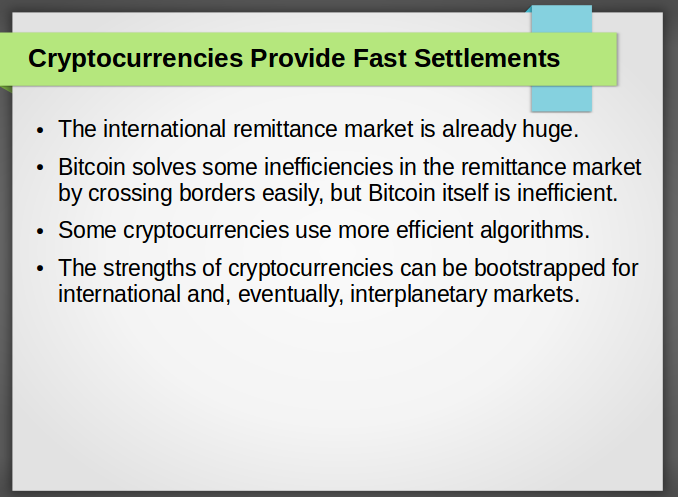
The economy of many developing countries such as the Philippines depend on the remittances sent home by migrant workers. The value of these remittances are not to be underestimated because some estimates show that remittances sent to developing countries reached $700 billion in 2016. The problem here is that traditional remittance services could take days to process money that migrant workers send across international borders to their families. The delays could become worse if someone who has gone to Mars on a work contract wants to send some of his earnings home to his family. It’s very possible that the family may be living in poverty and may suffer even further hardship while waiting for that money to clear.
Even at its slowest, Bitcoin rarely takes more than an hour to process a transaction. On the rare occasions that it does, there’s usually some kind of logjam in the network from processors trying to handle a vastly higher number of transactions than normal. When the time delay in communications between Earth and Mars is factored in, a remittance sent by a worker on Mars to his or her family back on Earth will almost never take more than a day to process. This means that an impoverished family back on Earth will be able to use the money sent to them much faster than they would with a traditional remittance service.
Many cryptocurrency insiders say that the logjam problem, plus the high transaction fees that Bitcoin users have been paying lately, make a good case for offloading microtransactions on the level of buying a cup of coffee at your favorite cafe to users’ choice of the most popular “alternative” cryptocurrencies. In fact, Bitcoin is actually regarded as the least efficient cryptocurrency. The person or group using the alias Satoshi Nakamoto deliberately made it inefficient by using an encryption algorithm called SHA-256, which was originally designed to provide government level encryption for security purposes. Mining rigs designed to provide processing power for Bitcoin are clunky, noisy, generate a lot of heat, and suck up a lot of electricity. If the price of Bitcoin wasn’t so high, it’s unlikely that Bitcoin would ever have been able to command many petaflops’ worth of processing power.
Some developers of alternative cryptocurrencies, “altcoins,” have selected or developed more efficient algorithms that could make cryptocurrency-based remittances even faster. One popular, less resource-extensive algorithm is known as Scrypt, which was introduced with Litecoin. One of the most efficient cryptocurrencies is known as Groestlcoin, whose developers claim that the Groestl algorithm can be mined on a portable device like a laptop rather than specialized hardware like a typical Bitcoin mining rig.
There are some startups that are working on bootstrapping Bitcoin’s strengths to pay out the remittances in local currencies, such as Rebit.ph and Coin.ph subsidiary SendMoney. Companies like these will be able to send international and, more importantly to us, interplanetary remittances faster and cheaper than traditional remittances by taking advantage of cryptocurrency-based technologies.
Cryptocurrencies are Portable, Free of Middlemen and Politically Neutral
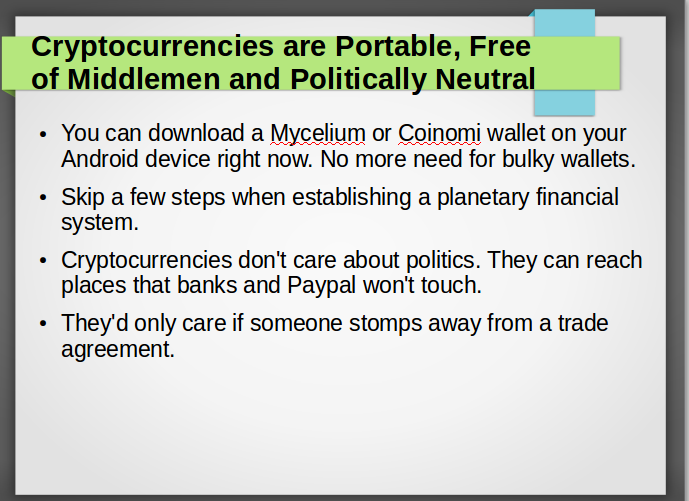
If you’re reading this, you’re probably connected to the Internet and can download a Bitcoin wallet in the Google Play store right now. If you’re using an Android device, I like the Mycelium wallet, Jaxx and Coinomi, though any wallet you choose will take some time to sync up with the Bitcoin network.
This is important because future interplanetary traders aren’t going to want to haul bulky paper currency or coins along their route and they aren’t going to want to wait weeks for a credit card payment to clear or, worse, risk some jerkoff customer issuing a fraudulent chargeback. Most cryptocurrencies don’t allow for chargebacks, which protects the vendor from losing money to fraud, but they do allow the trader to carry his currency on a mobile device on his belt. This is convenient for both the trader and the consumer and this allows the trader to save the trouble and expense of transporting bulky physical currency or waiting weeks for settlement.
In fact, you don’t even need third parties, AKA middlemen, when you’re using cryptocurrencies in their pure form. You don’t need banks, you don’t need Paypal, and you don’t even need those Bitcoin remittance services I mentioned. You just send the money over what amounts to a decentralized peer-to-peer network. This can actually help you save money because you’re reducing the number of people who have their fingers in the pie and taking their cut of any given transaction.
And, of course, Mars doesn’t have banks. With cryptocurrencies, future Martians can simply skip the step of establishing centralized financial institutions. The centralized system is being replaced with a new common standard, a decentralized cryptocurrency that is being secured by dedicated processing power. If you were here a few years ago, you might remember Lennart Lopin’s presentation on Marscoin. If you prefer a currency for interplanetary trade, though, you might try Solarcoin or Orbitcoin. Cryptocurrencies can entrench themselves in the future Martian economy while banks are still putting their pants on.
And cryptocurrencies are politically neutral. Cryptocurrencies are like Honey Badger; they just don’t care about debates on what a perfect Martian society would look like and they’re not going to be stopped by a silly wall no matter what any presidential candidate says. They can jump right over national borders and even reach regions that Paypal and financial institutions won’t touch for as long as users can connect to just one node on any particular cryptocurrency’s network. Anyway. Any given group of Martian colonies would still be able to trade with one another even if they disagree on matters of socioeconomic policy if they can simply agree on just one cryptocurrency to act as their standard for a medium of exchange.
The Secure Blockchain Ledger
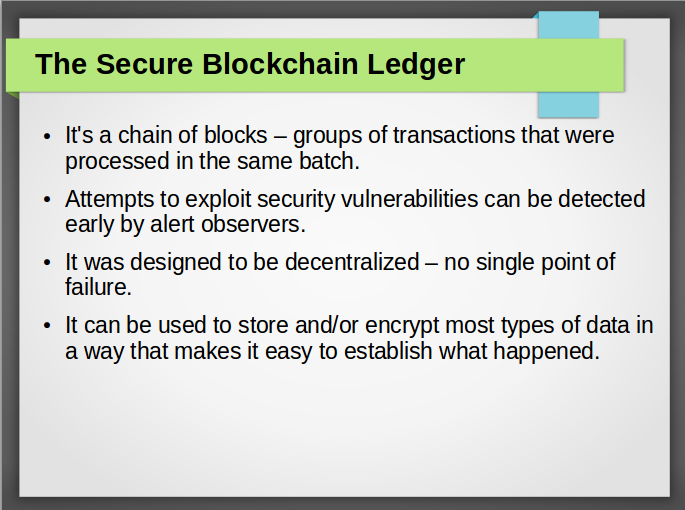
Stick around any moderately active cryptocurrency forum for a while and you’ll probably catch frequent mention of the Blockchain. Records on the Blockchain ledger are generally processed in batches called blocks. Once the first block, known as the genesis block, has been created, each subsequent block has a timestamp and a unique hash that has been calculated using the hash of the previous block. Each block effectively becomes a link on a chain that depends on the previous link to remain connected to the chain in any meaningful way.
Once the blocks have been created, they won’t be destroyed by anything short of a catastrophic meltdown of the network that contributes to the Blockchain (unlikely because a decentralized network does not have any single point of failure). They also can’t be altered in any way. Anyone who attempts to tamper with a Blockchain would have to do two things. He would have to create a fork in the chain at the point he wishes to make changes to, which would send up a lot of red flags for an alert Blockchain expert. He would also have to control more processing power than the original Blockchain for his fork to be considered a valid one. Considering that, at Bitcoin’s price peak in 2013, its decentralized network controlled a total of 1,000 petaflops, this could become quite expensive to an attacker.
The other way to attack a cryptocurrency would be to create fake nodes that don’t relay transaction data to the rest of the cryptocurrency network. It can be done, but as Chainalysis proved last year when it ran what was called a “partial Sybil attack,” such an attempt would be remarkably easy to detect. So easy, in fact, that it was detected by members of the Bitcointalk community. When your Bitcoin transaction isn’t being confirmed because the data isn’t being relayed, you kind of notice. Cryptocurrency experts can detect them and get them shut down as quickly as possible.
Cryptocurrencies were designed to be decentralized. This is another element that makes it possible for them to function without a third party, but it also means that a cryptocurrency network won’t care much whether there’s a node on Earth, a second on Mars, and a third on Pluto – except for the speed of light issue that would make rapid confirmation of transactions difficult. Sidechains can be set up to run parallel to the main Blockchain and temporarily store data until it’s convenient to exchange data with the Blockchain to speed up confirmation.
Another interesting thing about the Blockchain ledger is that it doesn’t really care about what kind of data is being stored on it. If you wish to prove that you had control of a document at any given point in time, you can encrypt it on the Bitcoin Blockchain and save the hash information for later lookup. But of course, owners of Bitcoin mining rigs might become annoyed if a lot of people are using Bitcoin to effectively execute a “poor man’s copyright” with large files. So it can be moved to a separate Blockchain-based storage system such as Storj. If you are living in an environment like Mars where there’s no judicial system in place yet, you want to sign a contract but you also want to make sure the other signatories keep up their end of the deal, you might make use of an Ethereum smart contract that will give you your money back if they flake.
Cryptocurrencies Reward The Production And Deployment Of Resources
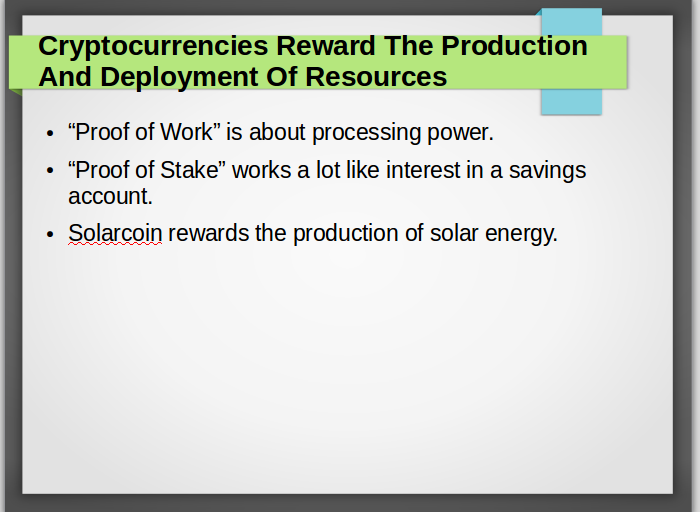
Securing most cryptocurrency networks relies on computing power. Which Martian colonies are going to invest in mining infrastructure, and what’s the payoff? Bitcoin and Marscoin reward the use of processing power to maintain the network with the chance to earn coins. Solve a hash function, get mining fees and a new block of coins.
But, as I said, Bitcoin mining rigs are clunky, noisy energy hogs. What colony wants that? Perhaps a colony might prefer a “Proof of Stake” cryptocurrency that effectively pays interest on currency that a colony might already own. If they become active participants in trade between colonies, they can be rewarded for producing surplus resources that they can sell to other colonies. One like Solarcoin, which rewards new currency based on the production of solar energy, might become more common with colonies that produce some or all of their power with solar panels. The important part: rewarding he production of resources that can be used for a colony to survive and thrive on Mars so that it can participate in the future interplanetary economy when trade starts happening.
The important thing here, of course, is to provide incentives for any colony who wants to use a particular cryptocurrency to also help maintain it. That means also providing incentives to produce and utilize resources like any processing power that the colony can spare, energy that can then be used by the colony, or the generation of surplus materials that can be sold on the open market.
